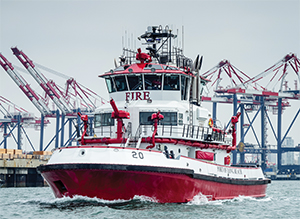The “May grays” had dropped a heavy morning curtain on Port of Long Beach, but the lack of sunshine did little to tarnish the gleam of Protector, the harbor’s new fireboat. Designed by Robert Allan Ltd. and built by Foss Maritime, the 108-foot vessel lit up the waterfront as it awaited duty last spring at the Fire Station 20 dock.
Moving beyond the sparkle and shine, the newbuild soon proved its mettle on a harbor run punctuated by an impressive display from its 10 water cannons. With the capability of unleashing 41,000 gallons per minute at distances up to 600 feet, Protector is, pound for pound, one of the most powerful fireboats in the world.
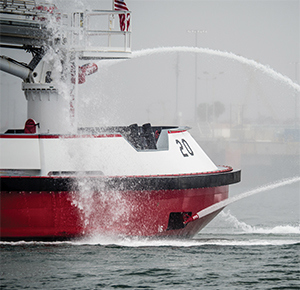 |
|
Two of the fireboat’s 10 FFS monitors are mounted low in the hull to provide an optimum angle for fighting fires under wharves. |
For local maritime interests, Protector’s arrival comes not a minute too soon. As the nation’s second-busiest seaport, Long Beach handles more than $140 billion of cargo a year — a number almost certain to grow in the era of mega-containerships. To respond to marine emergencies, the port has relied on a pair of aging fireboats: Challenger and Liberty, both in service for nearly 30 years and both with the capability of discharging only 10,000 gpm.
“We have a $4 billion capital improvement program that’s the largest among U.S. ports, but what’s important to note is we’re now in the ‘big ship’ era,” said George Gordon, senior program manager for the Port of Long Beach. “When our previous fireboats came into service around 1988, the ships calling here carried 4,500 containers. Today, the biggest ships coming to Long Beach have 18,000 containers. Protector can throw water or foam anywhere aboard these ships and the largest oil tankers.”
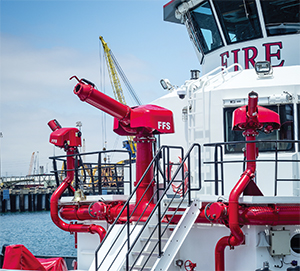 |
|
Protector’s most powerful deck monitor, at center, can fire 12,000 gpm up to 600 feet. |
The scope of missions that fireboats face has also changed since Challenger and Liberty took to the water. Three decades ago, operations primarily involved fire attack, dewatering, hazmat cleanup and deploying containment booms for fuel spills. In the post-9/11 world, there are new threats and the need for new contingencies. Protector is designed and equipped to act as a command-and-control center, enabling emergency responders to coordinate efforts on scene instead of from the shore. The deckhouse citadel can be sealed from chemical, biological, radiological and nuclear (CBRN) threats, and the boat has a military-grade HVAC system to protect the crew from airborne contaminants. The same multi-mission capability will be available in Vigilance, Protector’s sister, which is scheduled for delivery to the port in early 2017.
“(Protector) is completely CBRN capable,” said Michael Lorton, fireboat engineer for the Port of Long Beach, during a tour of the boat in mid-May. “We have a full hazmat containment area on the boat where you can do all of your treatment for anyone who has been involved in an incident. The boat is equipped with a dive platform and also has a 40-ton bollard for towing, which the old boats did not have. The way the port looks at it, if we have a vessel that is in trouble or is blocking the entrance to the channel, this boat can be used to move that vessel just like a tugboat can be used.”
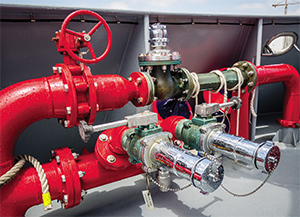 |
|
Freshly cleaned, one of the boat’s three eductors and a pair of hose manifolds glisten in the sun. There are four pumping systems on the boat — designated red, green, blue and white — with matching color-coded labels for the operators. |
Protector and Vigilance have many of the same features as Fireboat 2, a Robert Allan-designed vessel delivered to the city of Los Angeles in 2003. One of the chief similarities is cycloidal propulsion, which allows the fireboats to be extremely maneuverable, especially at low speeds.
“Fireboat 2 has performed very well for L.A. and we have been impressed by her capabilities,” Gordon said. “The vessels often work together (in San Pedro Bay) and have a common operating profile, so they have similar capability requirements. Rather than copy the L.A. boat directly, we did our homework and conducted a structured assessment of our vessel needs before starting the design process. We looked at several options for the overall design, engine types and propulsion configurations. In the end, we decided that a vessel with a Voith Schneider system similar to that of L.A. was the most compatible with our needs.”
The cycloidal system’s “eggbeater” propellers allow Protector to spin in circles within its own length and improve its ability to stay on station while fighting a fire. The design also enables the fireboat to travel perpendicularly to a wharf or another vessel with ease to target it with water or foam. A downside is the deeper reach of the propellers: Protector draws 15 feet of water, typically more than boats of similar size with traditional propellers.
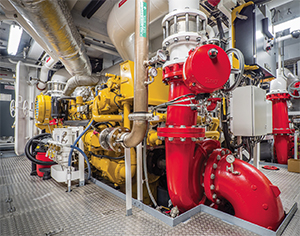 |
|
Main aft pump engine No. 2 is one of four Caterpillar 3512Cs on Protector. |
Given Long Beach’s characteristics — the main channel is one of North America’s deepest at 76 feet, with depths of 50 feet or more at five of the port’s six container terminals — the tradeoff was well worth making to gain the extra maneuverability and stability.
“With a twin-screw boat, when you’re trying to fight a fire in a specific location or sweep your monitors from right to left, you need to be operating constantly if you’re on the sticks, trying to move, move, move, and it’s much more dangerous,” Lorton said. “Trying to stay on target with multiple fire streams can be difficult (with traditional propellers). With the Voith, you’re able to operate the vessel at full speed, full rpm, forward, backward, spin in a circle. That’s a big advantage for us — not only to not be affected by using the fire streams at the same time, but to have full operation at any rpm in any direction. And you can move one inch at a time. You can’t do that with a twin-screw vessel, especially in the wind.”
Long Beach’s decision to go with cycloidal propulsion for its new fireboats was not a big issue for Robert Allan Ltd., which has a history of designing tugboats with similar drives, said Henry Reeve, senior naval architect for the company based in Vancouver, British Columbia.
“As designers we have a very good relationship with Voith and work with them on projects all the time,” he said. “It’s a little different for construction, but even that’s not huge. The biggest factor with the cycloidal drives is they’re much easier to operate, more intuitive for the operators.”
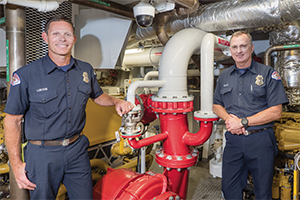 |
|
Fire engineers Michael Lorton and Robert Keller flank FFS pump No. 1, which can be clutched into the starboard main engine to provide 7,500 gpm of foam output. |
Protector’s Voith Schneider props are driven by a pair of Caterpillar 3512C main engines producing 2,012 hp each at 1,600 rpm. Auxiliary power on the Tier 3 vessel is provided by two Caterpillar C6.6 gensets. Top speed is 12 knots, with a harbor patrol speed of 8 knots.
For firefighting, Protector has two additional Caterpillar 3512Cs and a Caterpillar C12 that team with the main engines to power seven pumps ranging from 2,000 gpm to 8,000 gpm. Two of the pumps are driven by the diesel mains; in firefighting mode, propulsion power is limited to about 25 percent, with 75 percent available for the fire pumps. The system allows Protector to remain fuel efficient on station while boosting pump power without additional engines.
The fireboat is equipped with 10 FFS monitors, the largest of which is capable of delivering 12,000 gpm up to 600 feet. The nine other monitors range from 1,500 to 6,000 gpm; two can deliver 6,000 gpm of firefighting foam up to 500 feet. The largest monitor alone exceeds the requirements of a National Fire Protection Association (NFPA) Type II fireboat, according to the Long Beach Fireboats website.
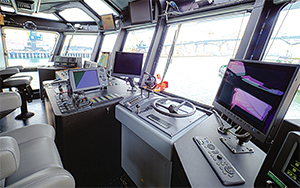 |
|
Protector’s aft console features an array of Furuno electronics, including a NavNet 3D radar system and AIS. |
Two of the monitors are positioned in the hull for underwharf duty. “Those are capable of (firing) fog, straight stream,” Lorton said. “They have about a 140-degree radius, so they’re very useful. They’re about 2,000 gpm apiece.”
Long Beach’s firefighters took a hands-on approach in Protector’s evolution from blueprint to active duty, joining Robert Allan personnel from the beginning of the design. Their pride was evident during the dockside tour in May, reflected in the polished deck equipment and the care taken in cleaning the vessel after the display by its monitors in the harbor.
“We went down every couple of months over the course of a couple of years to go through the full design process,” Reeve said. “We sat in a room with a dozen firefighters, trying to listen to all of their input. A couple of the guys had operated Fireboat 2 and the rest of the guys had been out on Fireboat 2, but they each also had their own operational experience that comes into play. They had a lot of ideas of things we should do. Sometimes it worked out, but sometimes we had to say we can’t implement that suggestion for these various reasons. But they really got involved.”

